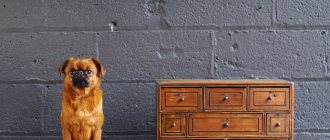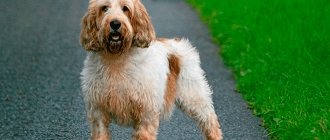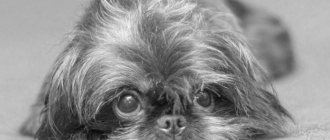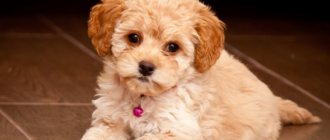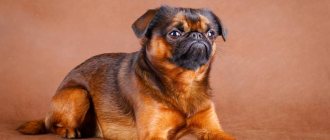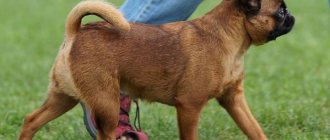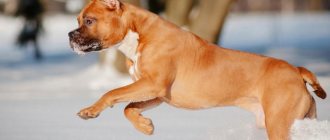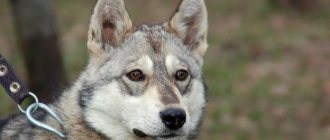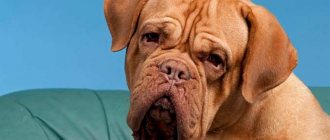Perhaps, any pet lover has heard of such a breed as the Belgian Griffon - this dog is very popular in many European countries. But in Russia it has not taken root - you can meet representatives of the breed very rarely and only in large cities. But still, many readers would probably be interested in learning more about the griffin breed.
Proud and pleased with myself
History of the variety
It should be noted right away that the Griffon is a non-existent breed of dog. More precisely, it is a composite image that includes several breeds. All of them belong to small Belgian dogs.
It's difficult to say when they originally appeared. But already in the nineteenth century, miniature dogs perfectly protected sheds and barns from mice and rats.
But over time, they were appreciated by aristocrats and simply wealthy people, who decided that a small dog would look much better in a luxurious living room than in a barn. So they turned into decorative pets.
For reference! For the first time one of the breeds was demonstrated at the exhibition in 1880.
Anal glands.
For some dogs, this is a constant source of trouble. Small anal glands are located on either side of the anus. Overflow of secretions causes inflammation. If the glands are not cleared of their contents, they can become infected and form abscesses that burst and open out. The anal glands can be cleaned by the owner himself, but if in doubt, it is best to consult a veterinarian.
Constant attention and timely cleaning will help avoid long-term treatment and complications that a dog causes by licking itchy areas, such as weeping eczema.
Characteristics and description of varieties
As mentioned above, the concept of griffon often includes several breeds bred in parallel. To better understand the issue, you should study each of them separately.
They do not differ too much in size - on average, height at the withers is 26-32 centimeters with a weight of about 3.5-6 kilograms. But still there are differences and very noticeable ones.
Brussels
Perhaps the most common member of the family. It has a very hard, wiry coat. Not too long, but very thick, allowing both to withstand bad weather and protect against rat bites.
The main color is brown and all its shades. Quite often there is a black mask on the face.
Belgian
Externally, the Belgian Griffon is similar to the Brussels Griffon. In fact, the only difference is the color - this breed is characterized by black and black and tan coats.
Brabançon
If the reader is interested in the smooth-haired griffon, then he should give preference to the Brabançon (not the Barbados, as some believe!). Or, more precisely, Petit Brabançon - that’s what this breed is called.
Her coat is short, but at the same time quite tough. There are different colors: red, black, black and tan. Moreover, red-haired individuals often have a black mask.
British (English) fawn basset griffon
The breed developed in parallel from those listed above and, in fact, apart from a similar name, has nothing in common.
Basset griffins are much larger - at the withers about 39-45 cm with a weight of 18-20 kg.
The ears are long and the coat is straight. The color can be tri-color, but in most cases white dogs are found.
Corthals Griffon or French Wirehaired Griffon
The Korthals Griffon is not at all similar to the Belgian.
Like the Basset Griffon, it has nothing to do with the small Belgian breeds. Actually, it’s not even a griffon, but a pointer. Height at the withers is 50-60 cm (bitches are usually about 5 cm shorter).
They were bred in the mid-sixteenth century and were actively used in hunting. The coat is tough, but feels more like boar bristles than wire, like real griffons.
The usual color is steel gray, sometimes with brown markings. But the standard also allows brown-white, brown-roan, and any combination of these colors.
Advantages and disadvantages
Each dog has certain advantages and disadvantages. It is very important to know about them in order to be able to choose a pet that will definitely not disappoint. And the griffon is a dog that is no exception.
Interesting! The mortality rate for griffon puppies is quite high. But the surviving dogs very rarely get sick with anything.
The main advantages are:
- Good health and excellent immunity.
- Excellent character - friendly, positive, balanced.
- Thick coat that perfectly protects the dog from cold, wind and rain.
- Endurance.
Alas, there are some weak points here. For example, the griffin dog is quite expensive in Russia, and throughout the post-Soviet space. And due to their rarity, it can be very difficult to find a pair for mating.
In addition, childbirth is quite difficult, which makes this breed not the best choice for first-time owners.
The structure of the muzzle is very unusual
Nutrition
The Brussels Griffon needs a balanced diet, which takes into account the required levels of protein, carbohydrates, calcium and phosphorus. For a small dog, split meals are considered the most acceptable. The volume of portions and their calorie content are determined based on the age and activity of the pet. If the dog runs and plays a lot, the food should be high in calories. For a calmer dog, the caloric content of foods can be reduced. Small puppies and older dogs should receive smaller portions more often. A veterinarian will help you accurately determine the nutritional plan and set of products, based on the individual characteristics of the dog.
Dog breeders often have a dilemma about what to feed the griffon: natural food or special food.
The main advantage of special dog food is the correct balance of substances. Also, the owner does not need to think about what, when and how to give. If you have no experience in keeping a griffon, then it is better to focus on this feeding option.
It is important to choose high-quality feed and comply with quantitative standards. It is believed that dry food can harm the animal to some extent, but this fear is exaggerated
It is much worse if the dog, while consuming natural products, does not receive the amount of minerals and vitamins that it needs.
So, the diet of the Brussels Griffon should include:
- lean meat;
- porridge;
- offal;
- vegetables seasoned with vegetable oil;
- sea fish without bones;
- cottage cheese and sour cream;
- milk (in small quantities);
- raw eggs.
Breed standard
To avoid getting into trouble when choosing a pet, it would be a good idea to learn more about the standards that experts set for the breed. After all, the requirements here are quite strict.
Head
For a miniature dog, his head is quite large. At the same time, the muzzle is very unusual - flat and with special proportions, which makes it look like a human face. Around the eyes, on the chin and cheekbones, the hair is especially coarse, long and tousled.
Jaws and teeth
The lower jaw is wide, slightly curved upward. Slightly longer than the top one, due to which an undershot characteristic of the breed is formed - in this case this is not a defect.
The incisors on both jaws are positioned so that they form a straight line. The mouth is tightly closed so that the tongue and teeth do not stick out - this can already be regarded as a defect.
Attention! Experts always pay attention to the chin - its width and protruding part - it must be harmonious.
Nose
It has a very non-standard fit - at the same level as the eyes. The lobe is black, with widely opened nostrils, and wide. The tip is tilted back, which is especially noticeable when you look at it from the side.
Eyes
Round and large, set wide, but at the same time not too prominent. Usually there is a dark color - like brown. It is important to ensure that the entire area of the eye is dark - the whites should not be visible. Light-colored, oval or too small eyes may be considered a defect.
Ears
Small, planted high and quite far from each other. If they are not cropped, the ears hang slightly forward, being only half erect. If they are too large or hang to one side, this may be considered a defect by experts.
When docked, they stand firmly and have sharp ends. Depending on the standards of the federation operating in a particular country, docking may or may not be mandatory.
Interesting! It is still unknown exactly what breeds the griffon came from. Possible ancestors include Terrier, Smoushond, French Barbet and Affen Pinscher.
Neck
Not too long, but strong. The transition from head to withers is very smooth, not clearly expressed.
Frame
The length of the body and its height at the withers are almost the same. Because of this, the small dog looks quite strong and powerful - and all thanks to its almost square format.
Limbs
Both front and rear should be spaced quite widely. The paws themselves are round, small, facing forward - not turned in or out. Tightly clenched (but not fused) fingers. The pads are dark, almost black, thick. The claws are preferably dark or even black.
Tail
Set on high and carried up. When docked, about 2/3 of the tail remains. The tip faces the back, but should not curl, break or touch the back.
Features of cutting a griffin with a clipper
It is difficult to clip a Griffon if the dog has not been trained to inspection and obedience since childhood. Such trimming is required only in the abdominal areas and intimate places, otherwise the coat loses its structure. Peculiarities:
- Don't cut your dog's hair too short. The hair should remain of medium length.
- To give a neat look, it is enough to shorten the long areas, and not the entire coat.
- Use only rounded scissors to avoid damaging the skin.
Disqualifying faults
Due to the structure of the jaw, the dog seems to be always unhappy.
At the exhibition, the black griffin is a rather rare dog. Therefore, judges carefully study each representative of the breed.
The following deviations are considered defects:
- White spots.
- Color deviations from those specified in the standard.
- Protrusion of the upper jaw over the lower jaw.
- Skewed lower jaw.
- Not a black nose.
- When the mouth is closed, the tongue is still visible.
How to choose a pet
The Belgian Griffon is a rare and difficult breed to breed. Therefore, searching for a puppy can take a lot of time. To buy a healthy and purebred dog, you need to contact certified single-breed nurseries or trusted breeders.
Before buying a puppy, it is advisable to ask:
- the presence of a mark and metrics;
- conditions of detention;
- health status;
- compliance with the breed standard.
Important! A large, forehead-shaped head combined with a miniature body indicates the presence of genetic mutations and the presence of the dwarfism gene. Therefore, it is better to refuse to buy such a puppy.
Hygiene
Hygiene is quite simple - little more difficult than when working with short-haired dogs.
- Every week you need to comb out the hair - a comb with sparse teeth is suitable for this.
- Griffon grooming should be done as rarely as possible - only before performances and exhibitions.
- But partial trimming of the griffon will have to be done every month - it is necessary to trim the hair near the anus so that it does not get dirty.
Important! After each meal, you need to wipe or wash the “beard” - it constantly gets dirty.
Examination of eyes and ears - every day. If your eyes are watery, wipe them with a cotton swab dipped in tea leaves. Clean your ears with ear sticks slightly moistened in warm water.
Tartar can cause certain problems - to prevent its occurrence, it is advisable to regularly give the dog bones or toys that are intended for dogs that like to chew something.
A gorgeous beard is the pride of a griffin
Choosing a puppy
Purchasing a puppy from a breed nursery is not a momentary matter. First, you should sign up several months in advance to get a little griffon, such is the popularity of this rather rare breed. And the livestock is small, since only two, less often three, puppies are born in a litter. And the birth of four is considered simply a huge contribution to the development of the breed.
A small miracle - a Brussels Griffon puppy, an active, extremely active and immensely charming creature. Babies are not a priori afraid of humans, and willingly go into the arms of strangers. A visual inspection of the purchased baby consists of examining the eyes, ears, dental system and appearance of the baby.
An important fact when choosing a puppy is the absence of signs of rickets. In naturally healthy dogs, bloating indicates only two things - rickets and the presence of worms in the gastrointestinal tract.
Lethargy, lack of interest in the surrounding space, fear caused by sharp sounds and the desire to hide in the far corner are not typical of a healthy puppy. The first step in such a case is to measure the temperature, and the next step is to consult a veterinarian.
The little griffon from the nursery is accompanied by a small dowry:
- Birth document - puppy with details of the parents and their pedigree number.
- Veterinary passport with entered vaccination dates.
- Photocopies of parents' health certificates.
- Tests to assess the health of the baby are possible.
- Photocopies of mother's and father's pedigrees.
- A favorite toy and a diaper soaked in the smell of the nursery so that the baby adapts faster
It is advisable to consult with the breeder on how to properly teach your baby to put on a diaper at home if walking will initially be temporarily limited.
Lifespan and reproduction
Of course, when getting a dog, any breeder will think about how many years it can live in a family. Well, life expectancy is quite good - on average 10-15 years. The spread is quite large, since the specific number largely depends on the quality of food, care, and regularity of visits to the veterinarian. In many ways, how long a pet will live depends on the attitude of the owner.
Males and females aged 10-12 months are suitable for breeding. But it is better to select older bitches - no younger than one and a half years old. Why? Because at this age the dog will be strong enough to give birth to healthy, strong puppies without risk to life.
Belgian Griffon Nail Care
Usually, when a dog regularly walks on asphalt, its claws wear off on their own, but this does not always happen, and therefore it is necessary to trim your dog’s claws. You can entrust this task to a veterinarian or a professional dog groomer, but if you want to do the procedure yourself, ask your veterinarian to show you how it's done. It is better to use a special nail trimming tool.
There are two types of dog nail clippers: scissors and guillotine. I prefer the guillotine, but it's a matter of taste. The most important thing in this procedure is not to hurt the dog. You will hurt her once and she will hate this procedure forever. To avoid causing pain or injuring your dog, only cut 2mm beyond the red area of the nail. When in doubt, it is better to cut less. A puppy's nails should be trimmed at 2-3 weeks of age to avoid scratching the mother's belly. Accustoming your dog to this procedure from an early age is the best method to avoid unpleasant moments in the future.
